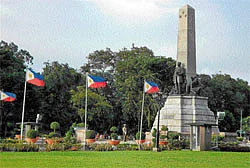The Philippines has often been treated as a ‘stop-over’ en route to other nearby tourist attractions. R Mohan babu offers the visitor reasons to stay on, just a little bit longer.

The Philippines is an awesome archipelago with 7,107 islands, many of them uninhabited. Its long coastline, sandy beaches and blue waters beckon visitors to this south-east Asian country’s shores. As you land at Ninoy Aquino International Airport and reach the immigration counter, a board proclaims, “Mabuhay,” meaning ‘welcome’ in the widely-spoken Tagalog language.
The Philippines recently changed its USP from “Wow Philippines” to “It is more fun in the Philippines.” The new slogan is now accompanied by several new spots to capture the foreigner’s imagination, thus boosting income from tourism. After slowly moving towards the top slot in the BPO sector, the Philippines is now gearing up to attract tourists, who have until now preferred to visit the likes of Singapore, Malaysia and Thailand.
Manila, the capital of the Philippines, offers several attractions to tourists, ranging from historical and cultural monuments to attractive and well-maintained parks, nightlife, sea food, casinos and bustling malls. A rolling tour of Manila took me to some important places like the Makati business district, Jose Rizal Park, National Museum, Manila Hotel, Aguinaldo Shrine, Coconut Palace, Sunset Boulevard and SM Mall of Asia, which is supposed to be the biggest in the region.
A slice of history
Our guide explained how Rizal, a Filipino polymath, patriot and the most prominent advocate for reform in the Philippines during the Spanish colonial era, is regarded as the foremost Filipino patriot and is listed as one of the national heroes of the Philippines. At Fort Santiago, where Rizal was imprisoned before his execution, the authorities have recreated the route used by Rizal during his imprisonment. Embedded onto the ground here, are bronzed footsteps representing Rizal’s final walk from his prison cell to the place of his execution. In the museum, they have preserved a couple of books and other materials associated with Rizal.
One gets an opportunity to travel in a kalesa, a horse-driven carriage, which is almost similar to the sarot in India. A drive through the marine area was a heartening experience as the workers were busy restoring the boulevard, which was battered by a typhoon.
A peek into culture
Another eye-catching place is the Coconut Palace, built in 1978. According to the guide, it is made of several types of Philippine hardwood, coconut shells and specially engineered coconut lumber. Each of the suites on the second floor is named after a specific region of the Philippines and displays some of the handicrafts produced in these regions. Before becoming the official residence of the vice president, the palace was best known for wedding receptions. The octagon-shaped palace has a hat-shaped roof. The palace has a chandelier made of 101 coconut shells and a dining table inlaid with 40,000 tiny pieces of coconut shells.
Highlighted as one of the cultural centres of the Philippines, the most striking features of the palace are its architecture and interiors. Also, the palace celebrates the coconut as the ultimate ‘tree of life’. From the coconut’s roots to its trunk, bark, fruit, flower and shell, the palace’s design, form and ornamentation echo this sentiment.
A taste of commerce
The last stop of the tour was the impressive Asia Mall. Asia Mall in EDSA at Bay City in Pasay City is a must-see for any visitor to Manila. A tourist can shop till he drops in this marvellous building. But the market that is likely to interest Indian tourists is Greenhills. The busy market area, which offers a wide variety of articles, is best known for hard bargains.
Another place that is a must-see for the tourist is Macati, which is a business district full of skyscrapers. Macati is always bustling with a lot of activity as most of the embassies and headquarters of leading companies are housed in this area.
What is most impressive is that these places of interest are well-maintained. One can hardly see litter near monuments. I was told by the guide that littering is an offence and a third attempt at littering would lead to imprisonment.
For those interested in gambling, options are aplenty — one can bet on horse races, take their chance with the lottery or try their luck at casinos, like the one housed in the Resorts World. Resorts World also offers a variety of entertainment programmes every evening, perhaps to help gamblers recover from their losses! I was treated to an interesting and impressive Filipino cultural programme — a couple of participants shook their legs to a bamboo dance, a dance much like the dances in the north-eastern parts of India.
While in this country, one cannot miss two interesting vehicles on the road: jeepneys (jeeps converted into vans to carry around 20 people at a time) and three-wheeled motorbikes that have a lot of boot space. I was told by officials and people that the jeepney is more or less Manila transport’s lifeline, and are now even being exported to New Papua Guinea.
Over the years, the crime rate has considerably fallen, making the city more safe, claim tourism officials. Barring typhoons during the monsoon season and the occasional earthquake, there should be no other reason for a tourist to not visit the Philippines.
